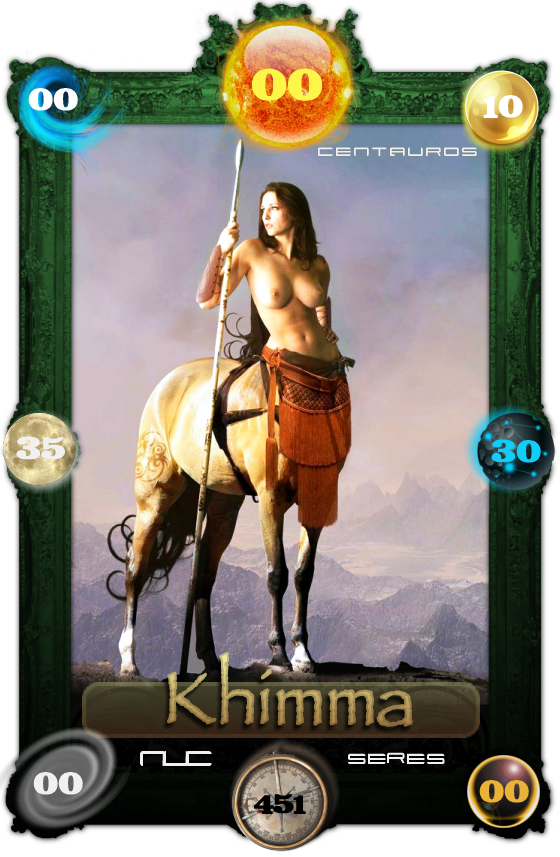Khímma
Beings - Centaurs
Card 451
Battle Area:
- Water = 00
- Earth = 35
- Heaven = 00
Attack and Defense
- Wisdom = 10
- Dexterity and Strength = 30
- Powers = 00
- Fire = 00
Game
NUC Cards is a board game. With trays representing the opponents' lands and the battlefield.
The characters exist timelessly. In one era, historical, mythological and literary characters meet in this game.
An epic oxygen game of great kings, notable warriors, heroes and anti-heroes, mighty magicians and gods between creatures and beings ...
Sign up and get access to rules details and more cards.
Collect!
Khímma
Beings - Centaurs
Khimma, is a beautiful centaur of the Antrohipo tribe, skillful and domineering centaur in the use of spears.
In Greek mythology, the centaur (in Greek Κένταυρος, Kentauros, "matador de toros", plural Κένταυρι, Kentauri, in Latin Centaurus / Centauri) is a creature with head, arms and back of a human being and with body and legs of horse .
The centaurs lived in the mountains of Thessaly and were divided into two families:
The children of Íxion and Nefele, who symbolized the brute, senseless and blind force. They originally lived in the mountains of Thessaly and ate raw meat. Alternatively, they were considered children of Kentauros (the son of Íxion and Nefele) and some mares magnésias, or of Apolo and Hebe. It is said that Íxion planned to have sexual relations with Hera, but Zeus, her husband, avoided it by modeling a cloud (nefele, in Greek) with the form of Hera. Since Ixion is usually considered the ancestor of centaurs, they can be referred to poetically as Ixonyids.
The children of Filira and Cronos, among which the most famous was Quiron, friend of Heracles, represented, on the contrary, the strength allied to goodness, at the service of good combats.
The centaurs are well known for the struggle they had with the Lapitas, provoked by their attempt to kidnap Hippodamia on his wedding day with Pirítoo, king of the Lapitas and also son of Íxion. The discussion between these cousins is a metaphor for the conflict between low instincts and civilized behavior in humanity. Theseus, hero and founder of cities, who was present, tipped the balance towards the right order of things and helped Pirítoo. The centaurs were expelled from Thessaly and went to live in Epirus. Later, Héracles (Hercules) exterminated almost everyone.
Scenes from the battle between the Lapitas and the Centaurs were sculpted in low reliefs on the Parthenon frieze, which was dedicated to the goddess of wisdom, Athena.
The origin of this mythical creature is surrounded by ramifications, but most place the criminal Ixion as ancestral. You can refer to them poetically as Ixiônidas. It is said that Ixion tried to cut off the goddess Hera. Zeus created a cloud (Nefele, in Greek) with the format of the goddess, conferred the existence and was distracted seeing his rival dishonoring the false Hera. From that relationship Kentauros was conceived, which would later give rise to offspring from crosses with mares.
Of these beings, only the centaurs Chiron and Fire flee to the angry stereotype of their fellows. The first was the result of the union between the titan Cronos and the naiad of Filira; and the second came from the relationship between Silenus and Melos nymph. Therefore, neither of them were descendants of Ixion, thus protecting themselves from their truculence.
NUC Cards ® 2019
Reasoning and strategy.
An advanced game of underground strategy in generation.
